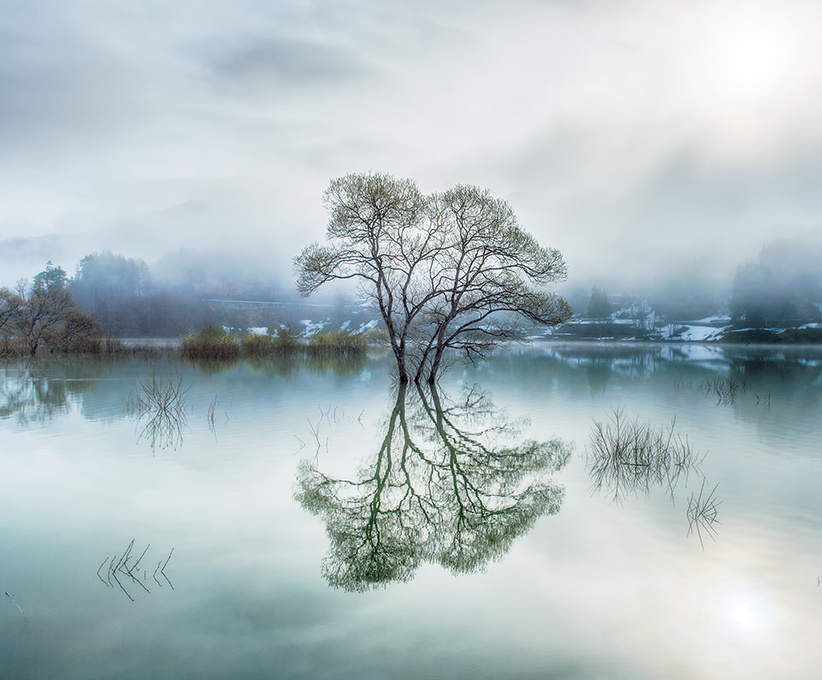Forest of Misty Vision
This work was shot over a period of seven years in the forest of Shirakawa Lake, which is flooded by meltwater for a month in the spring. Themes of the work are "the world woven by the humidity", unique to the northern basin surrounded by mountains; "the world woven by mountains, forests, and rivers" that create it; and "reality and unreality.
The abundance of water is also a testament to the existence of harsh winters with deep snow. The world of trees budding just as the snow melts and being shrouded in mist, reflected on the surface of the lake of melted snow, has a beauty that touches the depths of the heart. There exists a world where reality and unreality are mixed together.
Surrounded by mountains including the Iide mountain range, Iide Town in Yamagata Prefecture receives heavy snowfall in winter that piles up to several meters high. In April, when the snow begins to melt, meltwater flows in from the Shirakawa, Hirokawara, and Koya Rivers. For a month from the end of winter to early summer, the broad-leafed trees, mainly the "white willow" that grow in clusters in Shirakawa Lake, filled with snowmelt water, that floods the forest. In the early morning, the water surface changes from light blue to emerald green, depending on the angle of view.
The thick fog peculiar to the area creates a fantastic reflection of the submerged trees. Gradually, the submerged forests sprout new greenery and change their beauty into fresh green submerged forests. As spring passes, the melting snow flows into the fields to grow crops, and the submerged forests resurface.
The four seasons are beautiful, with the heat of summer and deep snow in the winter unique to the basin, and the "humid" scenery of Yamagata. Here are the beauty and nature of mountains, forests, and rivers.
Lake Shirakawa was originally a river, located at the uppermost reaches of the Shirakawa Dam, which was built for flood control purposes. The submerged forest of Shirakawa Lake is the result of the Shirakawa Dam being filled with snowmelt. Dams have the advantage of preventing flood damage, but they also cause environmental destruction. Dams prevent the increase of aquatic life such as mountain stream fish as well as their migration upstream and downstream, including spawning runs. The sediment that was supposed to flow with heavy rains and large amounts of snowmelt does not flow downstream but accumulates in the river. The bottom of the river is then gradually filled with sand and many aquatic organisms are deprived of their homes. Changing nature to make it easier for people to live in leads to environmental destruction to a greater or lesser extent. The reality of people's lives and the reality of environmental destruction. Both are right, and what is right is not always right.
On the other hand, the scene of the trees budding as the snow melts and being wrapped in mist, reflected on the surface of the water, does not seem to have any impact on the environment because they are so beautiful. The fact of the environmental destruction and the beauty seem to co-exist in the space between reality and unreality that goes against this fact. Reality is a very strange thing.
Was the fantastic forest in flooded water an illusion?
As if it was just an illusion shrouded in mist, the forest in water is fleetingly returning to the forest on earth...
山々に囲まれた北国の盆地特有の『湿度』が織りなす世界、それを創り出す『山と森と川が織りなす世界』、『現実と非現実』をテーマに、 春の一ヶ月間姿を現す白川湖の水没林を 7 年間に渡り撮影した作品です。
豊かな水は、雪深い過酷な冬が存在する証でもあります。雪解けと同じくして芽吹き、霧に包まれる木々が雪解け水の湖面に映し出される 世界は、心の奥に触れる美しさをもっています。現実と非現実が入り混じる世界がそこには存在します。
飯豊連峰をはじめとした山々に囲まれ、冬には積雪が数メートルにもなる山形県飯豊町。雪解けが始まる 4 月には白川、広河原川、小屋川 から雪解け水が流れ込みます。冬の終わりから初夏にかけての一ヶ月間、白川湖に群生する「シロヤナギ」を中心とした広葉樹が雪解け水 で満たされ水没森が姿を現します。早朝には朝靄がかかり、水面は見る角度によってライトブルーからエメラルドグリーンへと様々な色合い に変化してゆきます。
その地域特有の濃い霧が発生し水没した木々を幻想的に映し出します。水没林は次第に新緑へと芽吹き、新緑の水没林へと美しさを変えて ゆく。そうして春が過ぎると雪解け水は田園へと流れ込み作物を育て、水没林は森へと還ってゆくのです。
四季の変化が美しく、盆地特有の夏の暑さと雪深い冬、山形の『湿度』ある風景...ここには山と森と川が織り成す自然と美しさがあります。
白川湖はもともと川でしたが、治水を目的に建設された白川ダムの最上流にあります。白川湖の水没森は、白川ダムが雪解け水で満たされる ことで生まれた光景です。ダムには洪水被害を防ぐという利点がありますが、同時に環境破壊も引き起こしています。ダムは渓流魚などの水生 生物の増加と産卵期の遡上を含めた上下流への移動を妨げます。大雨や大量の雪解け水と共に流れるはずだった土砂は、下流には流れず 川に溜まります。その後、川の底は徐々に砂で満たされ多くの水生生物が住処を奪われてゆくのです。人々が住みやすくするために自然を 変えることは それは多かれ少なかれ環境破壊につながります。人々の生活の現実と環境破壊という現実。どちらも正しく、正しいことは 必ずしも正しいとは限りません。
一方で、雪解けと同じくして芽吹き、霧に包まれる木々が水面に映し出された光景は環境への影響など感じさせず、この事実に反する現実と 非現実の狭間に存在するかの様な美しさを持ち合わせています。現実とはとても不思議なものです。
その幻想的な『水の森』は幻だったのだろうか... まるで霧に包まれた幻だったかのように、『水の森』は儚く森へと還ってゆきます...

















